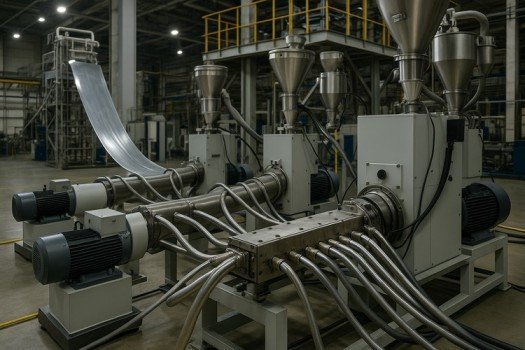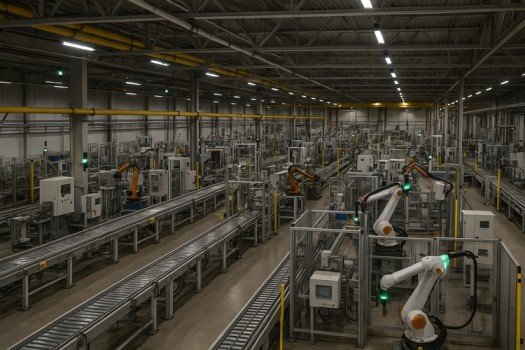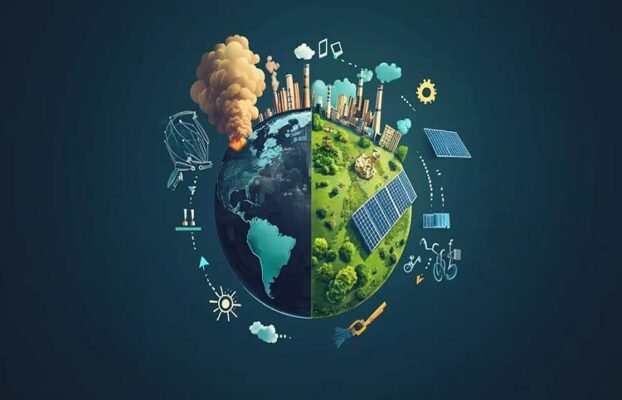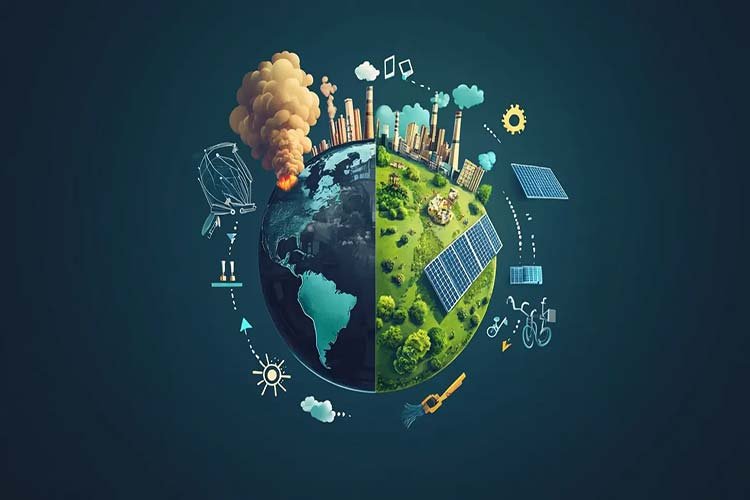Most manufacturers think upgrading their extrusion lines means buying the latest machine until they walk into a facility running AI-powered systems and realize they’ve been operating in the Stone Age. Modern film and sheet extrusion technologies aren’t just shinier versions of what came before—they’re fundamentally different animals.
These systems think, learn, and adapt. They catch problems before they happen, optimize themselves while running, and handle materials that would have given traditional equipment a nervous breakdown. Film and sheet extrusion technologies have evolved from mechanical processes to intelligent manufacturing ecosystems that redefine what’s possible in plastics production.
TL;DR Summary
- AI systems now control extrusion processes in real-time, predicting issues before they tank your production run
- Advanced co-extrusion creates films with up to eleven layers, each doing something different and useful
- IoT sensors turn your production line into a data goldmine that actually helps you make better decisions
- New processing tech handles recycled materials without the headaches that used to come with sustainable manufacturing
- Automation has gotten smart enough to replace the expertise that’s walking out the door with retiring technicians
- Picking the right technology partner matters more than the equipment specs themselves
Current Challenges Driving Technology Adoption
Quality inconsistencies remain the biggest pain point—you expect uniform thickness but end up with film that looks like a topographical map. Traditional systems just keep pushing plastic through the die without optimization.
Energy costs keep climbing while older extrusion lines burn through power unnecessarily. The skilled technician shortage compounds these issues since retiring operators take decades of troubleshooting knowledge with them. New technology steps in to bridge that gap through intelligent automation.
Environmental regulations demand systems that handle recycled content, reduce energy consumption, and minimize waste while maintaining quality specifications.

Revolutionary Technologies Transforming Film and Sheet Extrusion
The convergence of computing power and manufacturing precision has created possibilities that seemed like science fiction just a few years ago. These new innovations in extrusion lines aren’t incremental improvements—they’re paradigm shifts that change how manufacturers approach production control and quality management.
AI-Powered Process Control Systems
AI in extrusion goes way beyond simple monitoring. These systems analyze thousands of data points per second, learning from every production run to predict optimal settings for new materials or changed conditions. According to McKinsey’s latest research, organizations across industries are rapidly adopting AI technologies to address operational challenges and competitive pressures.
These systems catch problems that human operators miss completely. Temperature drift in zone 7 that would cause thickness variations three hours later gets corrected before anyone notices the problem developing. What used to require decades of operator experience now happens automatically through pattern recognition and real-time optimization.
Process control algorithms make adjustments faster than human reflexes allow. When the material feed rate fluctuates or the ambient humidity changes, the system compensates instantly rather than waiting for manual adjustments. Vision systems combined with AI analysis detect defects within milliseconds, triggering immediate corrections rather than producing unusable material.
Advanced Co-Extrusion Innovations
Advanced co-extrusion has moved beyond simply stacking layers. Modern systems create films where each layer serves a specific purpose—barrier protection, structural strength, heat sealability, or optical properties. This targeted approach delivers performance that single-layer films simply cannot match.
The technology improvements solve the flow distribution problems that plagued early multi-layer systems. Advanced manifold designs ensure each material stream maintains consistent flow rates across the full web width, eliminating the thickness bands that used to drive quality inspectors crazy.
Blown film applications benefit from sophisticated cooling control that treats each layer differently. Cast film/sheet production uses die lip adjustment mechanisms that respond to continuous thickness measurements. Material compatibility solutions enable processing combinations that weren’t practical before, opening new possibilities for flexible packaging applications that require complex barrier properties.
Industry 4.0 Integration with IoT Sensors
Industry 4.0 implementation creates production lines that communicate and share information across the entire manufacturing process. IoT sensors monitor everything from screw wear patterns to ambient humidity levels, affecting material handling and final product properties.
Digital twin technology lets engineers test process changes in virtual environments before implementing them on actual equipment. Predictive maintenance systems analyze vibration signatures and power consumption patterns to identify components approaching failure, enabling maintenance based on actual usage rather than predetermined schedules.
Comprehensive sensor networks provide visibility into processes that were previously invisible. Material moisture content, screw torque variations, and die lip temperature gradients become manageable variables rather than mysterious factors affecting product quality. According to IBM’s Industry 4.0 research, manufacturers implementing connected systems achieve significant improvements in operational efficiency and product consistency.
Sustainable Material Processing Technologies
Processing eco-materials presents challenges that conventional equipment wasn’t designed to handle. Post-consumer recycled materials contain contaminants, moisture, and property variations that require specialized processing approaches.
Enhanced filtration systems remove contaminants while preserving material properties. Multi-stage filtration combined with continuous monitoring prevents contaminated material from reaching the die while maximizing yield from recycled feedstock. Research from ScienceDirect demonstrates how advanced processing techniques successfully handle the variability inherent in recycled material streams.
Bio-based polymer processing requires modified temperature profiles and screw geometries that accommodate materials with different thermal stability characteristics. Recyclability considerations now influence equipment design from initial specifications, supporting closed-loop manufacturing where production waste gets reprocessed immediately rather than sent for external recycling. This approach reduces carbon footprint while maintaining material quality.
Enhanced material performance through advanced processing ensures recycled content meets the same standards as virgin materials.
Next-Generation Automation and Control
Extrusion line automation coordinates material handling, processing, quality control, and finished product management into integrated workflows. Advanced control systems manage multiple extruders and downstream equipment to optimize overall line efficiency.
Automatic gauge control systems continuously measure film properties across the web width, making real-time adjustments to maintain thickness uniformity within specifications that manual control cannot achieve consistently. Vision-based quality systems inspect products at production speed, identifying contamination and defects while automatically removing defective products without disrupting production flow.
Integrated line management systems coordinate upstream material preparation with downstream product handling to maximize throughput while minimizing inventory requirements. Remote monitoring enables expert support across multiple facilities from centralized control rooms.
| Technology Category | Primary Benefits | Implementation Complexity | ROI Timeline |
| AI Process Control | Quality consistency, waste reduction | High | 12-18 months |
| Advanced Co-Extrusion | Product differentiation, barrier performance | Medium-High | 18-24 months |
| IoT Integration | Real-time monitoring, predictive maintenance | Medium | 6-12 months |
| Sustainable Processing | Regulatory compliance, material flexibility | Medium | 24-36 months |
| Advanced Automation | Labor efficiency, consistency | High | 18-30 months |

Implementation Strategies for Modern Extrusion Operations
Technology integration requires honest assessment of current capabilities and realistic timelines for building internal expertise. Phased adoption approaches minimize disruption—start with monitoring and data collection systems that provide immediate insights without requiring major equipment modifications.
An effective production line strategy requires balancing immediate operational needs with future technology evolution. Equipment choices should support incremental upgrades rather than requiring complete system replacement. Training programs represent critical success factors that organizations often underestimate.
Future Innovations on the Horizon
Film and sheet extrusion technologies continue evolving as research institutions and equipment manufacturers develop next-generation capabilities. Nanotechnology applications will enable precise control of material properties at the molecular level, creating specialty films with properties tailored for specific high-performance applications.
Additive manufacturing integration represents an emerging area where traditional extrusion combines with 3D printing capabilities. This convergence enables the production of complex geometries and customized products that bridge mass production with bespoke manufacturing requirements.
Machine learning systems will manage entire production ecosystems automatically. The future of extrusion lies in these intelligent systems that can predict market demands and adjust production parameters automatically. Modern sheet production systems will incorporate these connected capabilities to optimize everything from raw material procurement to finished product delivery.
Selecting Technology Partners and Solutions
Partnership evaluation requires assessment of technological capabilities and long-term support commitments. Equipment purchases represent just the beginning of relationships that extend throughout equipment operational life.
Organizations like Plentiful Choices combine deep technical knowledge with practical implementation experience across diverse manufacturing environments. This combination ensures advanced technologies integrate seamlessly with existing operations while delivering measurable performance improvements.
Global reach combined with local presence provides access to worldwide innovations while ensuring responsive customer service. Service capabilities directly impact operational reliability and cost-effectiveness through comprehensive support programs.
Conclusion
The transformation happening in extrusion technology represents a fundamental shift rather than equipment evolution. Film and sheet extrusion technologies now integrate artificial intelligence, comprehensive automation, and sustainable processing techniques that redefine manufacturing possibilities for forward-thinking companies.
Manufacturers embracing these innovations gain competitive advantages through improved product quality, operational efficiency, and market responsiveness. The convergence of AI-powered systems, advanced co-extrusion capabilities, and comprehensive automation creates differentiation opportunities that extend beyond traditional cost competition.
Success requires strategic technology partnerships combining cutting-edge innovations with practical implementation expertise. Working with experienced partners who understand technological possibilities and practical implementation challenges ensures investments in film and sheet extrusion technologies deliver maximum value while supporting long-term strategic objectives. Revolutionary change requires revolutionary technology adoption—incremental improvements no longer provide sufficient competitive advantage in today’s rapidly evolving manufacturing landscape.
FAQ
AI systems provide predictive optimization that prevents problems rather than just detecting them. This means consistent product quality, reduced waste, and elimination of the guesswork that leads to production delays and material losses.
Start with monitoring and data collection to build familiarity with connected systems. This foundation provides immediate value through better process visibility while preparing teams for more advanced automation implementation.
Advanced filtration, moisture removal, and specialized processing parameters enable consistent recycled material processing while maintaining product quality. Enhanced control systems compensate for the variability inherent in recycled material streams.
Evaluate implementation experience, long-term support capabilities, and commitment to ongoing innovation. Partners should demonstrate proven success in similar applications while providing comprehensive training and maintenance programs.








